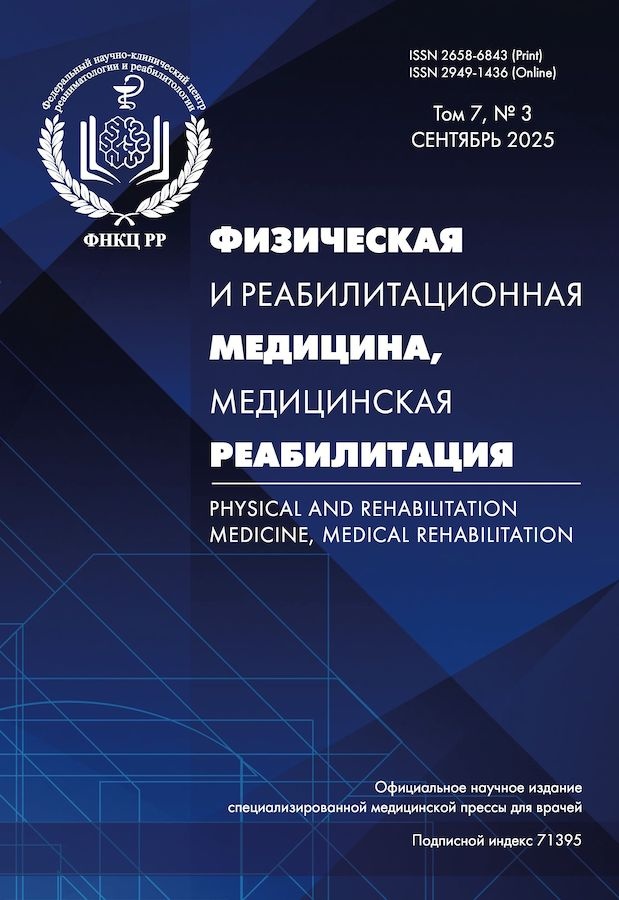Rehabilitation Route for a Child with Cerebral Palsy: the Experience of Chuvashia
- Authors: Yakovleva S.K.1, Andreeva V.E.1, Preobrazhenskaya E.V.1, Petrova R.V.1, Milova O.I.2, Shafeykina E.V.3, Makarova E.V.1
-
Affiliations:
- Federal State Budget InstitutionFederal Center of Traumatology, Orthopedics and Arthroplasty of Ministry of Health of the Russian Federation
- Republican Children's Clinical Hospital of the Ministry of Health of Chuvashia
- Rehabilitation Center for Children and Adolescents with Disabilities of the Ministry of Labor and Social Protection of Chuvashia
- Issue: Vol 3, No 1 (2021)
- Pages: 149-158
- Section: New methods and technologies, discussions
- URL: https://journal-vniispk.ru/2658-6843/article/view/46598
- DOI: https://doi.org/10.36425/rehab46598
- ID: 46598
Cite item
Full Text
Abstract
The most common cause of neurological disability in childhood is cerebral palsy. The objectives of the treatment of children with cerebral palsy are the acquisition and maintenance of new motor skills; prevention of the development of contractures and other secondary orthopedic complications; decrease in the level of pain; improving the level of childcare. At the same time, the provision of treatment and rehabilitation assistance to children with cerebral palsy requires an integrated, systematic approach. The article describes the route of rehabilitation of children with cerebral palsy in the Chuvash Republic from the moment of diagnosis until reaching the age of 18. The study was carried out on the basis of an analysis of data from the regional register of children with cerebral palsy at all stages of treatment and rehabilitation (habilitation). The first stage includes the identification of risk groups for cerebral palsy, conservative, surgical specialized medical care. The register of children with cerebral palsy made it possible to keep records of patients at the stages of treatment and rehabilitation with an assessment of the results. At the second stage, high-tech conservative and surgical treatment is carried out. After operations, patients are sent for rehabilitation to a 24-hour hospital or to a Rehabilitation Center for Children (over 3 years, 1.5 thousand children were treated, 25.7% — after operations). The third stage is organized at the outpatient clinic level and in specialized sanatoriums. For 2014–2018 the coverage of children with cerebral palsy with conservative treatment increased 1.9 times, with botulinum therapy — 2.6 times, the proportion of those who received surgery decreased to 22.4%. 92.7% of patients of the Register are covered by conservative treatment. 33.3% of operated children were referred for sanatorium-resort treatment. The control section of the rehabilitation results showed an increase in the proportion of children with improved gait quality, the ability to stand independently, walk (with support), and an increase in the average level of physical activity. A multi-level system of interagency interaction in the provision of treatment and rehabilitation assistance to children with cerebral palsy in Chuvash Republic made it possible to ensure a sufficient amount of basic and availability of highly qualified medical care, effective management and control of the stages of rehabilitation.
Full Text
##article.viewOnOriginalSite##About the authors
Svetlana K. Yakovleva
Federal State Budget InstitutionFederal Center of Traumatology, Orthopedics and Arthroplasty of Ministry of Health of the Russian Federation
Email: yakovleva.sk@mail.ru
ORCID iD: 0000-0003-2583-7408
SPIN-code: 9145-3334
MD
Russian Federation, 33, F. Gladkova street, Cheboksary, 428020Vera E. Andreeva
Federal State Budget InstitutionFederal Center of Traumatology, Orthopedics and Arthroplasty of Ministry of Health of the Russian Federation
Email: vbarieva@mail.ru
ORCID iD: 0000-0001-8341-3481
SPIN-code: 5783-6429
Cand. Sci. (Med.)
Russian Federation, 33, F. Gladkova street, Cheboksary, 428020Elena V. Preobrazhenskaya
Federal State Budget InstitutionFederal Center of Traumatology, Orthopedics and Arthroplasty of Ministry of Health of the Russian Federation
Author for correspondence.
Email: alenka_22@bk.ru
ORCID iD: 0000-0003-3556-145X
SPIN-code: 1525-3912
MD
Russian Federation, 33, F. Gladkova street, Cheboksary, 428020Roza V. Petrova
Federal State Budget InstitutionFederal Center of Traumatology, Orthopedics and Arthroplasty of Ministry of Health of the Russian Federation
Email: rozaproza18@gmail.com
ORCID iD: 0000-0002-9596-4309
SPIN-code: 1555-1352
MDRussian Federation, 33, F. Gladkova street, Cheboksary, 428020
Oksana I. Milova
Republican Children's Clinical Hospital of the Ministry of Health of Chuvashia
Email: milova.rdkb@yandex.ru
SPIN-code: 5412-8669
MD
Russian Federation, CheboksaryElena V. Shafeykina
Rehabilitation Center for Children and Adolescents with Disabilities of the Ministry of Labor and Social Protection of Chuvashia
Email: rgucentr@yandex.ru
ORCID iD: 0000-0003-2343-4007
SPIN-code: 6156-5405
MD
Russian Federation, CheboksaryElena V. Makarova
Federal State Budget InstitutionFederal Center of Traumatology, Orthopedics and Arthroplasty of Ministry of Health of the Russian Federation
Email: emakarova@orthosceb.com
ORCID iD: 0000-0001-6527-481X
MD
Russian Federation, 428020, Чувашская Республика - Чувашия, г. Чебоксары, ул. Ф. Гладкова, д.33References
- Детский церебральный паралич (ДЦП): стандарты ведения больных для врачей.Клиническиерекомендации (утв. Союзом педиатров России). Москва, 2017. 62 с. [Infantile cerebral palsy: standards of patient management for physicians. Clinical recommendations (approved by the Union of Pediatricians of Russia). Moscow; 2017. 62 p. (In Russ).]
- Тонконоженко Н.Л., Клиточенко Г.В., Кривоножкина П.С., Малюжинская Н.В. Детский церебральный паралич: клинические рекомендации по лечению и прогноз // Лекарственный вестник. 2015. Т. 57, № 1. С. 26–30. [Tonkonozhenko NL, Klitochenko GV, Krivonozhkina PS, Malyuzhinskaya NV. Infantile cerebral palsy: clinical recommendations for treatment and prognosis. Medicinal Bulletin. 2015;57(1):26–30. (In Russ).]
- Куренков А.Л., Клочкова О.А., Бурсагова Б.И. и др. Применение препарата ботулинического токсина типа а (Ботокс) в лечении детского церебрального паралича // Нервно-мышечные болезни. 2014. № 3. С. 28–41. [Kurenkov AL, Klochkova OA, Bursagova BI, et al. The use of the drug botulinum toxin type a (Botox) in the treatment of cerebral palsy. Neuromuscular diseases. 2014;(3):28–41. (In Russ).]
- Алиева А.А., Алиева Х.М., Махмудова Т.А. и др. Характеристика реабилитационного потенциала и реабилитационного прогноза детей-инвалидов с детским церебральным параличом // Медико-социальная экспертиза и реабилитация. 2012. № 4. С. 24–27. [Alieva AA, Alieva HM, Makhmudova TA, et al. Characteristics of the rehabilitation potential and rehabilitation prognosis of disabled children with cerebral palsy. Medical and social expertise and rehabilitation. 2012;(4):24–27. (In Russ).]
- Palisano R, Rosenbaum PL, Walter S, et al. Development and reliability of a system to classify gross motor function in children with cerebral palsy. Dev Med Child Neurol. 1997; 39(4):214–223. doi: 10.1111/j.1469-8749.2010.03821.x
- Смычек В.Б. Основы МКФ. Минск, 2015. 432 с. [Smychek VB. Fundamentals of the ICF. Minsk; 2015. 432 p. (In Russ).]
- Heinen F, Desloovere K, Schroeder AS, et al. The updated European Consensus 2009 on the use of Botulinum toxin for children with cerebral palsy. Eur J Paediatr Neurol. 2010;14(1):45–66. doi: 10.1016/j.ejpn.2009.09.005
- Куренков А.Л., Батышева Т.Т., Виноградов А.В. и др. Первый Российский консенсус по применению многоуровневых инъекций abobotulinumtoxin A при лечении спастических форм детского церебрального паралича // Журнал неврологии и психиатрии им. С.С. Корсакова. 2016. Т. 116, № 11. С. 121–130. [Kurenkov AL, Batysheva TT, Vinogradov AV, et al. Spasticity in children cerebral palsy: diagnosis and treatment strategies. Zhurn. nevrol. ipsikhiat. im. S.S. Korsakova. 2016;116(11):121–130. (In Russ).] doi: 10.17116/jnevro2016116111121-130
- Методика неинвазивной электрической стимуляции в комплексной реабилитации детей с ДЦП. Учебное пособие / Под ред. А.Г. Баиндурашвили. Санкт-Петербург: СПб СРП «Павел» ВОГ, 2016. 40 с. [The method of noninvasive electrical stimulation in the complex rehabilitation of children with cerebral palsy. Training manual. Ed. by A.G. Baindurashvili. Saint Petersburg: St. Petersburg PSA «Pavel» VOG; 2016. 40 p. (In Russ).]
- Икоева Г.А., Кивоенко О.И., Полозенко О.Д. Роботизированная механотерапия в реабилитации детей с детским церебральным параличом после комплексного ортопедо-хирургического лечения // Неврология и нейрохирургия детского возраста. 2012. Т. 34, № 4. С. 32–36. [Ikoeva GA, Kivoenko OI, Polozenko OD. Robotic mechanotherapy in the rehabilitation of children with cerebral palsy after complex orthopedic and surgical treatment. Neurology and Neurosurgery of Children. 2012;34(4):32–36.(In Russ).]
- Яковлева С.К., Петрова Р.В., Грачева Т.М.и др. Опыт применения роботизированной механотерапии комплекса LOCOMAT PRO у детей с двигательными нарушениями в условиях ФГБУ «ФЦТОЭ» Минздрава России (г. Чебоксары) // Вопросы медицинской реабилитации: сб. науч. тр. по итогам Межрегион. науч.-практ. конф. Чебоксары: Изд-во Чуваш.ун-та, 2018. 188 с. [Yakovleva SK, Petrova RV, Gracheva TM, et al. Experience in the use of robotic mechanotherapy of the LOCOMAT PRO complex in children with motor disorders in the conditions of the Federal State Budget Institution Federal Center of Traumatology, Orthopedics and Arthroplasty (Cheboksary). Conference processing: Voprosy meditsinskoy rehabilitatsii: sb. nauch. tr. Cheboksary: Chuvash Publishing House; 2018. 188 p. (In Russ).]
- Пак Л.А. Мультидисциплинарное сопровождение детей с детским церебральным параличом: Автореф. дис. … докт. мед. наук. Москва, 2019. 47 с. [Pak LA. Multidisciplinary support of children with cerebral palsy [dissertation abstract]. Moscow; 2019. 47 p. (In Russ).]
- Amen J, El Gebeily M, El-Mikkawy DM, et al. Single-event multilevel surgery for crouching cerebral palsy children: Correlations with quality of life and functional mobility. J Musculoskelet Surg Res. 2018;2(4):148–155. doi: 10.4103/jmsr.jmsr_48_18
Supplementary files










